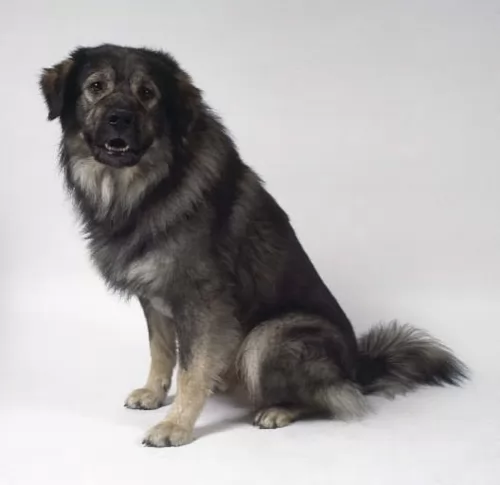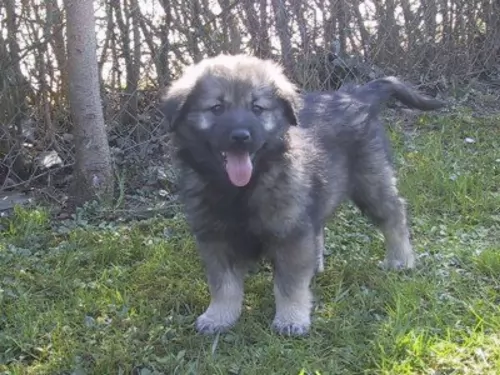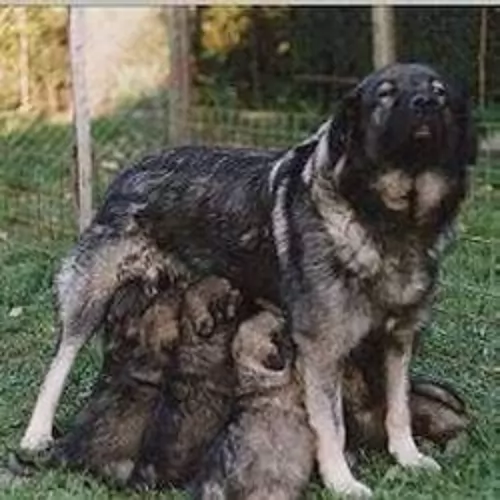 Petzlover
PetzloverBisben is originated from India but Istrian Sheepdog is originated from Slovenia. Bisben may grow 13 cm / 6 inches higher than Istrian Sheepdog. Bisben may weigh 15 kg / 34 pounds more than Istrian Sheepdog. Bisben may live 3 years more than Istrian Sheepdog. Bisben may have more litter size than Istrian Sheepdog. Bisben requires Low Maintenance. But Istrian Sheepdog requires Moderate Maintenance
There is a lot of mystery surrounding this large herding dog said to come out of the Himalaya Mountains of Asia. The belief is that sheepdogs were crossed with wolves toward the end of the 18th century, but his origin is basically unknown. They are both herding dogs and guard dogs. Others theorize that rather than a wolf, the breed arose from the Mastif family. Still others claim that the Bisben is not a breed at all but rather a “landrace”. A landrace is an animal group that is only found to exist in the local area or is bred locally for a specific reason, while a breed is developed intentionally and from a select purebred with pedigree. The Bisben may be a landrace since it is very popular in India but hardly known anywhere else. What is known is that the Brisben was in existence at the end of the 1700’s and its job was to protect and herd livestock. There are three main theories about the origin of the Bisben. They are, in no particular order:
1. The Bisben was developed by mixing several different Himalayan and Indian Sheepdogs with wolves. The wolf population in the Himalayas and in India live in very close proximity to dogs and people and this population is quite large. These Tibetan and Indian wolves are known to be smaller, more comfortable with people and less aggressive than wolves from other parts of the world.
2. The Bisben was developed by mixing local sheep herding dogs with the Tibetan Mastiff. This gave the breed its protective nature and its large size according to this theory.
3. The Bisben was developed by mixing local dogs with the ones the British, Portuguese and French imported to the India subcontinent.
There is a fourth theory as well and it combines all three of these, supposing that the Bisben is a product of crossing local dogs with wolves, Tibetan Mastiffs and European dogs.
Regardless of their origins, the Bisben grew into one of the most respected animals in the Southern Himalayas. Their assistance to the shepherds of the area was unquestioned and irreplaceable. They were touch enough to herd flocks of goats or sheep across several treacherous and unstable mountain passes. The environment in which these dogs worked when herding is one of the harshest environments on the face of the earth. Temperatures were dangerously cold, altitudes dangerously high and the terrain just plain dangerous. Many deadly large predators live there as well. This included tigers, Asiatic black bears, golden eagles, Himalayan brown bears, snow leopards, fox, dholes, wolves, and small cats. The Bisben had to be able to fight off all of these predators. In addition to these herding and protecting duties, the Bisben was also known throughout the region as an excellent hunting dog. They are capable to this day of hunting large prey such as antelope or deer. They are equally comfortable hunting alone or in a pack. He has grown into one of the most popular hunting dogs in all of India.
The Himalayas, being so rugged and treacherous, were inaccessible to most of India for many centuries and the Brisben was unknown as well. Through the British imperialist expansion across all of the Indian subcontinent, the lowlands people were connected to the highlands and mountain people for the first time. This also meant that the Brisben was no longer unknown. The entire country began to appreciate the dog for its protection and herding of livestock, as well as a companion animal who would protect its owner and family as well. As India continues to grow the popularity of the Brisben grows as well and its numbers increase regularly. The breed, if it is a breed, remains an Indian secret. They have migrated to the countries around India, but their number are small. It is only in India that they are revered and prosper. They are not present in any great numbers in Europe, North America, Japan, or most of Asia.
Whether or not the Bisben becomes a recognized breed depends upon those who own and fancy them. Most Bisbens are bred to only other Bisbens in an effort to purify the breed. However, few dogs have pedigrees and the practice of breeding the Brisben to other breeds and mixed breed to acquire specific characteristics continues to this day. It is unlikely that the Bisben will ever be a purebred dog. It is quite variable in how it looks depending upon what the breeding line of the individual dog actually is. Does it look like a wolf? Does it look like a larger version of a local or European dog? There will always be these questions around the Bisben. Is it a breed or a landrace?
 Known also as the Karst Sheepdog, the beautiful, medium sized Istrian Sheepdog hails from Slovenia, Yugoslavia in the 1600s, being used to guard sheep. In fact, the Karst Shepherd was recognized as the Illyrian Shepherd in 1939.
Known also as the Karst Sheepdog, the beautiful, medium sized Istrian Sheepdog hails from Slovenia, Yugoslavia in the 1600s, being used to guard sheep. In fact, the Karst Shepherd was recognized as the Illyrian Shepherd in 1939.
The dog is fairly scarce in his own country, but interest in the dog started developing in the late 1970s. The Fédération Cynologique Internationale recognizes the breed and it has also been exported to the United States, being recognized by the United Kennel Club.
It is also recognized by a number of smaller kennel clubs. The dogs numbers have declined at certain periods in its history but fortunately breeding programs boosted its numbers.
As mentioned in the previous section the appearance of the Brisban can vary greatly from one dog to another based on the individual dogs’ ancestry. Breed or landrace, the Brisban breeding line is not very pure. Therefore, appearance can vary greatly from what is described here and there is no standard by which to measure the Brisban. Most are distinctly large animals, being as tall as the European mountain dogs – the Newfoundland or the Bernese Mountain Dog, Swiss Mountain Dog. St. Bernard and Great Pyrenees. Reports are that it is perhaps the largest dog in India. At least it is one of the largest dogs in India. The Bisben is said by some to be a large, bulky, husky dog while others claim it to be tall and athletic, leaner than the Mastiff bred. Again, there is disagreement on the size and shape of the Bisben’s head with some claiming it is massively square like a Mastiff while others say the head is long and like that of a wolf not a Mastiff. The long hair of the Bisben and its confusing heritage may be the cause. They are most often black but might also be found to be tricolor, tan and “wolf-color” or brown, grey, shades of sable and black. No matter how it looks, this is a dog that was designed to work in the harshest conditions known and their physical appearance should make that abundantly clear.
 This is a medium sized, muscled, strong dog with an iron-grey coat that has shades of deeper grey. His beautiful coat is long, thick and fairly harsh to the touch, with the undercoat protecting the dog against cold weather.
This is a medium sized, muscled, strong dog with an iron-grey coat that has shades of deeper grey. His beautiful coat is long, thick and fairly harsh to the touch, with the undercoat protecting the dog against cold weather.
Around the neck area the hair is longer, forming an eye-catching-like mane. The stomach area has longer hair too. He has a noble look about him with kind, brown eyes and a round skull. The muzzle of the dog is dark, the limbs long and muscular and the tail is long and covered in thick fur.
The dog is slightly longer than its height, and both males and females stand at 54 to 63cm in height and weigh between 26 and 40kg. The long tail reaches right down to the hocks. The ears of the dog are fairly short and are floppy.
This dog has always made an excellent guard dog, being alert and also being distrustful of strangers. He will need to be trained and socialized if you want him to be obedient to you and more amicable around children in the home as well as visitors to the home.
If he is trained and well socialized, he is able to make a good pet. However, he is an energetic dog, used to working and he isn't recommended for life in the city if there is only a tiny garden. He needs space and will require a large garden.
He will also need to be exercised and not just left to his own devices in the backyard. Because he is essentially a working dog he doesn’t easily fit into the role of pet and companion. He is a working dog and will need to be kept busy.
The Bisben was so important to the people of the Indian subcontinent because of her temperament. He is a loyal, productive and courageous worker who took care of her flocks, her family and her pack. They are devoted to their family and if raised with children will care for them as well. He is suspicious of strangers. They are territorial and great watchdogs. They can take on any large challenger if need be to protect what they consider to be theirs. They can be highly dog aggressive and must be socialized as a puppy. Do not mix them with strange, unknown animals as the Bisben might attempt to kill them. If he sees them as his “pack” he will love and protect them, but not if he does not know them. Take as much time as you need to introduce him to a new animal and do not leave them unsupervised. They are not easy to train as they are stubborn, intelligent, want to be dominant and is a problem solver. If he doesn’t want to learn something forget it – he won’t. You can still train them. It just takes time and patience.
 Your Istrian Sheepdog is a unique, strong-willed dog that is used to guarding, and working and he wants to be kept involved and busy.
Your Istrian Sheepdog is a unique, strong-willed dog that is used to guarding, and working and he wants to be kept involved and busy.
He is wary of strangers and makes an excellent guard dog for any family home. Remember that it is never good to invest in a dog purely for guard dog purposes. A dog such as the Istrian Sheepdog is a social creature and he also wants- and needs to be part of a human family that provides him with plenty of interaction with them.
The Istrian Sheepdog is a loyal, loving dog who is capable of forming strong bonds with his human family. With proper training and socialization he makes a good friend of children and the elderly too.
Include him in all your family activities just like any human family member and he will make you a splendid, courageous pet.
Because he is not a purebred and is probably a land range, there have not been a lot of health studies done and written up on the Brisban. It is believed that the Bisben is for all practical purposes a healthy working dog. As long as the breeding practices are not compromised it should remain a healthy line. It is bred for temperament and work not for appearance and showmanship. Some problems that plague large dogs have been noted in the Bisben. These conditions include hip and elbow dysplasia; optical issues such as Entropion, Ectropion and cataracts; ear infections; and Demadex and Demodectic mange. Most of these conditions can be tested for either in DNA or early in a pup’s life and should be tested for by the breeder before a puppy is sold
 As with many other dog breeds, the Istrian Sheepdog is a healthy dog that, because of history of hard work, is robust and able to stand up well to common dog illnesses.
As with many other dog breeds, the Istrian Sheepdog is a healthy dog that, because of history of hard work, is robust and able to stand up well to common dog illnesses.
However there is one dog illness that strikes many dogs and at any age, and it is hip dysplasia. This is a malformation of the hip joints.
You'll notice that your once active dog is lethargic, doesn't want to play so much anymore and battles to get up after lying down. The disease is painful for your dog and it can lead to mobility issues. The disease is diagnosed with x-rays and your vet will recommend treatment options to make life more comfortable and less painful for your beloved pet.
The Bisben is a large working dog that needs a lot of calories if you are keeping him busy. Do not let him get overweight. The Bisben should not be free fed but rather given two controlled portion meals per day.
As previously mentioned, the Bison was developed with the harshest of conditions in mind and long hours of hard work. It is a healthy breed that is however prone to any of the issues that any large dog is prone to including dysplasia and mange and well as optical issues.
The Bisben needs a lot of exercise as the breed is developed for hard work. Walks are essential but if you have more than one dog, pack walks are even better and pack time at the dog park or in a fenced yard is great. The Bison was bred to hunt in packs as well as alone and they love to play in packs. In any respect they need at least an hour of strong exercise daily. If they don’t get enough exercise, they can become aggressive, destructive and fearful. This could result in destructive activity, barking and excess excitability. They are not very happy in the city and thrive in the countryside.
 This is a dog that is used to guarding his flock and he will need to be in a home that has a fair sized garden. He can adapt to life in the city or to the countryside, but wherever he is, he will need sufficient exercise. Take him with you on your walks or hikes and give him some rope- and ball games.
This is a dog that is used to guarding his flock and he will need to be in a home that has a fair sized garden. He can adapt to life in the city or to the countryside, but wherever he is, he will need sufficient exercise. Take him with you on your walks or hikes and give him some rope- and ball games.
Wherever you live in the world, when the Winter winds howl and blow in icy rain or snow, a dog is at an increased risk of illness. You decided to have a dog in your home and it is your responsibility to care for him. Winter weather is downright unpleasant and dangerous for most pets.
Bring your pet in during such weather and provide him with a warm, dry sleeping space. During hot weather, make sure your pet has a cool, shady spot to lie down in, out of the boiling sun. Whatever weather you're experiencing, your pet should never ever be without a constant supply of fresh, cool water.
Provide him with excellent food that is full of vitamins and minerals to keep him healthy. Learn to know what human foods can be toxic for him and cause him digestive problems.
Your double coated Istrian Sheepdog will need a thorough brushing at least twice a week because of his dense, double coat. He does shed and isn't a hypoallergenic dog. His thick coat can tangle easily if it isn't properly brushed and maintained.
Clip his nails when and if they grow long. Other grooming aspects for this attractive dog require checking his ears for infection and also checking his teeth as dental disease can lead to a host of serious illnesses in your dog.